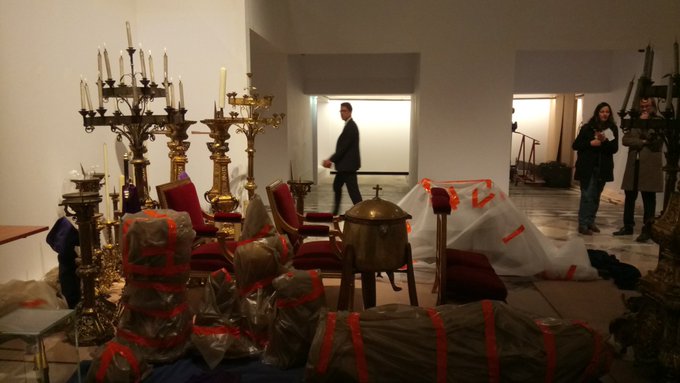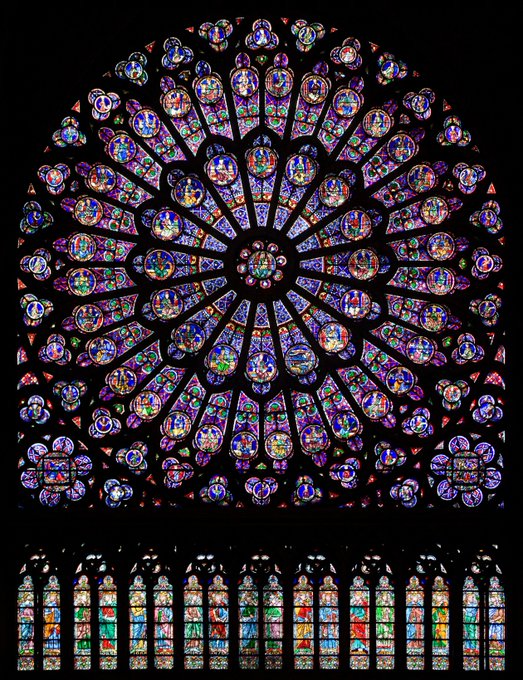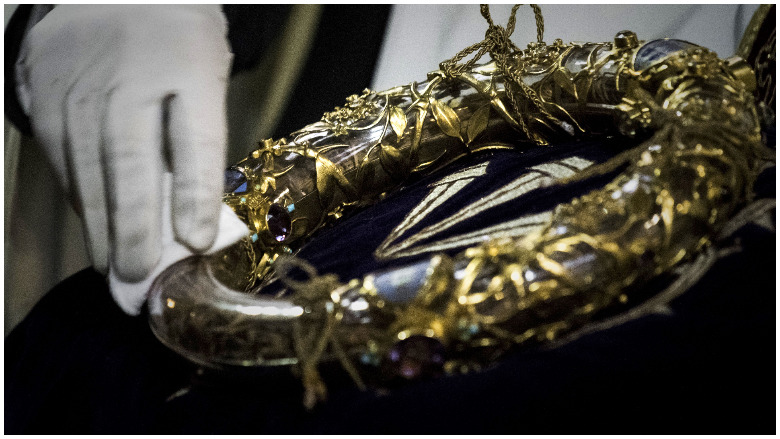
Getty What's said to be the crown of thorns was housed at Notre Dame.
Notre Dame Cathedral housed some of Christendom’s most sacred religious relics, included the crown of thorns, a woven circle that Jesus Christ was said to have worn to the Crucifixion.
A hero priest who serves as chaplain to the Paris fire services is credited with helping rescue the crown of thorns.
Thankfully, the crown of thorns – and some of the cathedral’s other relics – survived the fire that partially destroyed the famous landmark on April 15, 2019, according to Anne Hidalgo, the mayor of Paris.
“Thanks to the @PompiersParis, the police and the municipal agents who realized tonight a formidable human chain to save the works of #OurDame. The crown of thorns, the tunic of Saint Louis and several other major works are now in a safe place,” she wrote on Twitter. Msgr. Patrick Chauvet, the cathedral’s rector also confirmed to The New York Times that the crown of thorns was saved, along with the tunic and “a collection of chalices.”
According to Daily Mail, Father Jean-Marc Fournier, Chaplain of the Paris Firefighters, told reporters “he went into the burning cathedral to save the Blessed Sacrament and Crown of Thorns.” However, the fate of some relics is unknown; relics from St. Denis and St. Genevieve were located in the spire that burned to the ground. The spire may have also contained a separate fragment of the crown of thorns, reports The New York Post.
Here’s what you need to know:
The Priest Was Described as an ‘Absolute Hero’
Father Fournier has seen tragedy before; he comforted Parisians after the 2015 terrorist attacks, and he’s served as a chaplain in Afghanistan, CNN reports. So, when he saw the orange flames bursting from Notre Dame, he took no chances.
According to the Irish station NewsTalk, the crown of thorns “was brought to Paris by French King Louis IX 1238. The Church believes it is a relic of the wreath of thorns placed on the head of Jesus Christ at his crucifixion.” Chaplain Fournier sprang into action when the fire broke out, rushing inside the cathedral with firefighters to rescue the crown of thorns.
“Father Fournier is an absolute hero,” a member of the emergency services said to the station. “He showed no fear at all as he made straight for the relics inside the cathedral, and made sure they were saved. He deals with life and death every day, and shows no fear.”
A picture emerged showing works of art being carted out of the cathedral. It was posted by France’s culture minister, Franck Riester, who wrote, “@MinistereCC agents, supported by the archbishop’s teams, the @PompiersParis and the security forces, evacuate the works inside the cathedral. They are gradually made safe. #Our Lady.”
The building itself is also noteworthy: Its website describes it as a “masterpiece of gothic art.”
“The two towers of the cathedral are saved, but two-thirds of the roof has been ravaged,” reported the French language newspaper, LeMonde. The newspaper reported that, per General Jean-Claude Gallet, commander of the Paris Fire Brigade, the structure of the cathedral “is saved and preserved in its entirety.”
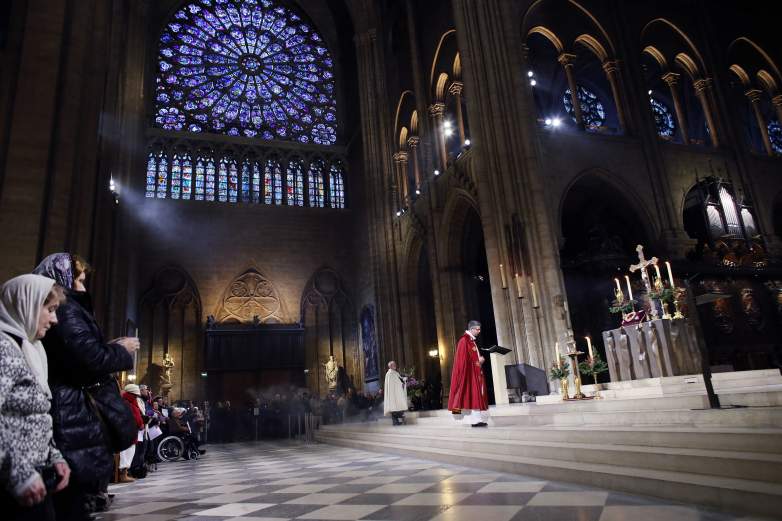
Believers attend a mass during the presentation to believers of the crown of thorns, one of the instruments of Jesus’ Passion at Notre-Dame de Paris cathedral, on December 7, 2012 in Paris. The Notre-Dame de Paris cathedral.
However, it’s what was inside that is even more precious. In addition to the crown of thorns, the cathedral housed what was believed to be a piece of Jesus Christ’s Cross and a nail used during the Crucifixion, according to its website. The fate of the latter two relics is not yet clear.
The cathedral’s website explains: “The relics of the passion presented at Notre-Dame de Paris are made up of a piece of the cross preserved in Rome and brought back by Saint Helena, mother of the Emperor Constantine, a nail of passion and the Holy crown of Thorns.”
A journalist for Paris Match, Nicolas Delesalle, wrote on Twitter: “Good news: all the works of art were saved. The treasure of the Cathedral is intact, the Crown of thorns, the Holy sacraments.” The three rose windows, the organ, and the great bell were also rescued.
Monsignor Chauvet, the rector, told The New York Times, though, that the fate of some “sculptures, paintings, stained glass windows and liturgical art and relics — remained unclear.”

Knights of the order of the Holy Sepulchre set the crown of thorns, one of the instruments of Jesus’ Passion on a display case during the presentation of the relic to believers at Notre-Dame de Paris cathedral, on December 7, 2012 in Paris. =
The roof and spire crumbled in the fire, but the entire building was not destroyed, and photos from inside show smoke billowing around what appears to be an intact altar. However, there were priceless antiquities housed inside Notre Dame. Although the cause is still under investigation, authorities suspect the blaze was an accident that might be linked to cathedral renovations.
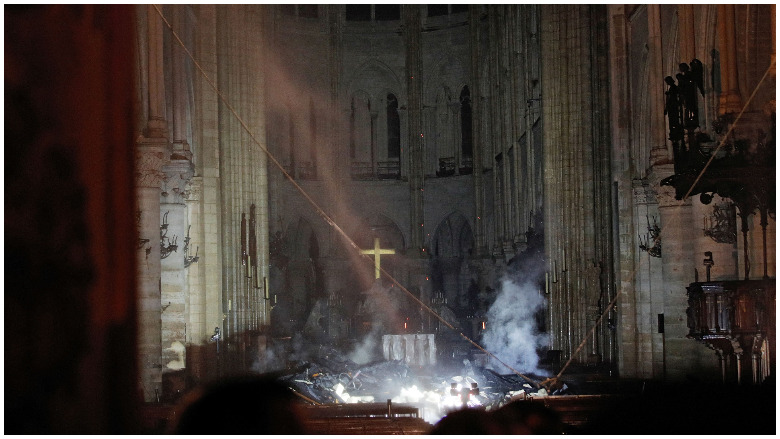
GettySee the first photos of Notre Dame fire damage inside the cathedral.
Here’s a listing of some of the treasures in Notre Dame:
The Crown of Thorns, a Nail & Piece of the Cross
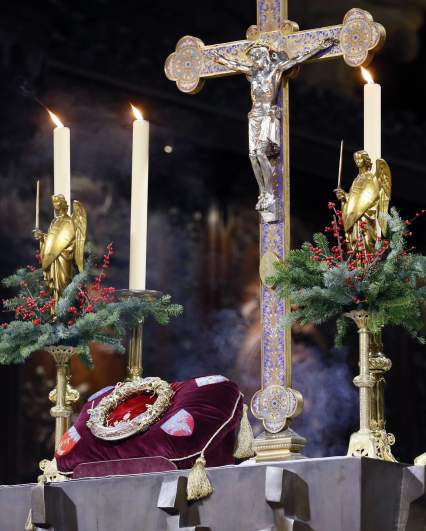
GettyThe crown of thorns, one of the instruments of Jesus’ Passion is set on a display case during its presentation to believers at Notre-Dame de Paris cathedral, on December 7, 2012 in Paris.
The crown of thorns is one of the most precious relics in Christendom. The Times quoted a professor as saying the crown of thorns at Notre Dame is said to contain fragments of the original circle worn by Jesus Christ.
According to SFGate, the crown of thorns (or at least pieces of it), which is displayed during Lent, “was believed to be placed on Jesus’ head leading up to his crucifixion.” It was stored “at the end of a nave of the cathedral, not readily visible to visitors,” The Sun reported.
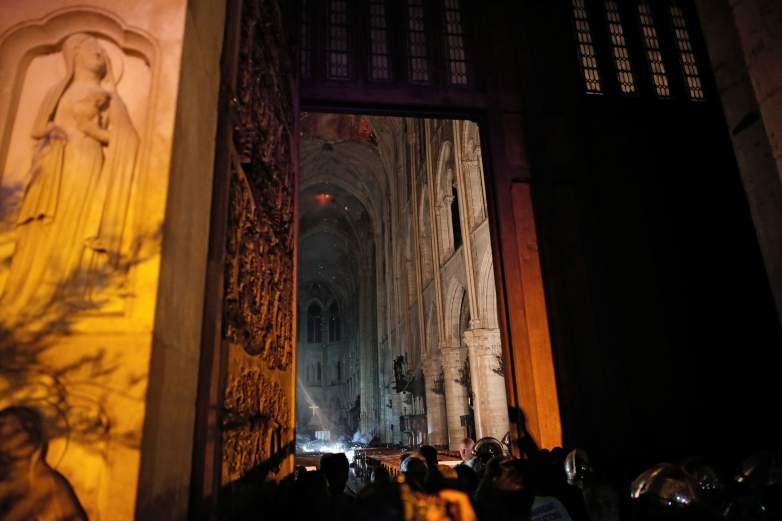
GettyThis general view from the entrance shows smoke rising in front of the altar cross at Notre-Dame Cathedral in Paris on April 15, 2019, after a fire engulfed the building.
According to AJC, this relic is not authenticated, but it’s believed to date to Christ’s Crucifixion. It’s described as “a braided circle of canes that according to Scripture, was placed on the head of Jesus Christ as he was tried by Pontius Pilot before his crucifixion,” the newspaper reported.
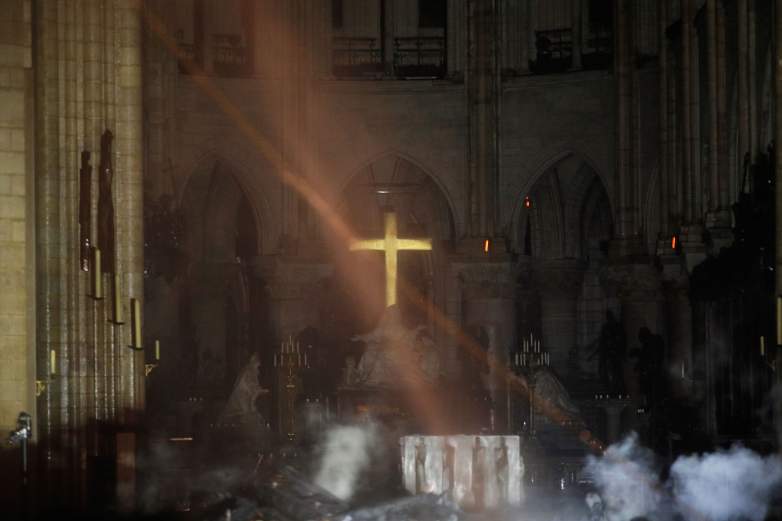
GettySmoke rises around the altar inside Notre Dame.
Notre Dame also housed a piece of what is said to be from the actual cross on which Jesus Christ was crucified, SFGate reported. AJC reports that Notre Dame also contains a nail believed to be from Christ’s cross and a stone that was supposed to be from the crucifixion site of Jesus Christ. The fate of those relics is not yet known.
The cathedral’s website explains further: “During the French Revolution, the relics will be deposited at the abbey of Saint-Denis and, devoid of their reliquaries, at the National Library. Following the Concordat of 1801, the Holy Crown is handed over in 1804, along with some other relics, to the Archbishop of Paris who assigns them to the treasure of the Cathedral on August 10, 1806. They are there preserved since then, entrusted to the canons of the Chapter in charge of their venerations and placed under the statutory guard of the Knights of the Holy Sepulcher of Jerusalem.”
The official newspaper of the Catholic Diocese of Green Bay, Wisconsin explains the history of the Crown of Thorns, writing, “Napoleon saved the crown of thorns and it was kept at the National Library until 1804. At that time, Christ’s crown was returned to the Archbishops of Paris and, in Aug. 10, 1806, was placed in the Cathedral of Notre Dame de Paris.”
The newspaper adds, “What we today know as the Christ’s crown of thorns can be unbrokenly traced back only to Constantinople, where many of the church’s treasures originally in Jerusalem were transferred to the Byzantine Empire between the fourth and the tenth centuries.”
According to that newspaper, the crown of thorns first arrived in Paris in the 1200s: “On Aug. 19, 1239, the relic of the crown of thorns arrived in Paris. Louis, a devout man who would later be canonized as St. Louis of France, took off his own crown and royal robes to walk barefoot behind the relic as it was carried to the unfinished Sainte-Chapelle, the chapel of the French kings.”
The Gargoyles
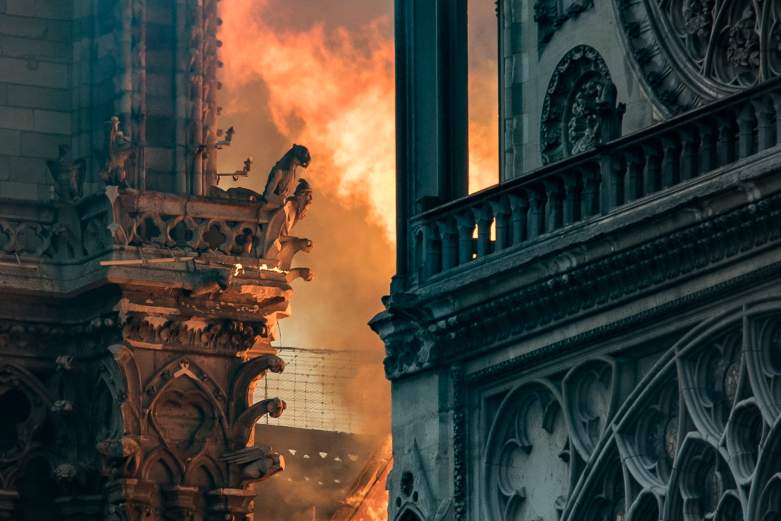
Flames and smoke billow around the gargoyles decorating the roof and sides of the Notre-Dame Cathedral in Paris on April 15, 2019.
Although it’s a spiritual pilgrimage for many, Notre Dame’s fame grew because of Victor Hugo’s classic novel, The Hunchback of Notre-Dame, cementing its place in literary history.
According to MyModernMet.com, the cathedral’s exterior featured “a menagerie of grotesques, stone creatures intended to protect the church from malevolent spirits.” These are the world-famous gargoyles. The gargoyles at Notre Dame date to the 1300s. The fate of the gargoyles is not yet clear.
The gargoyles served two main purposes; they were used as water spouts to protect the building’s stonework, and they were supposed to ward off evil spirits.
Famous Paintings & Statues
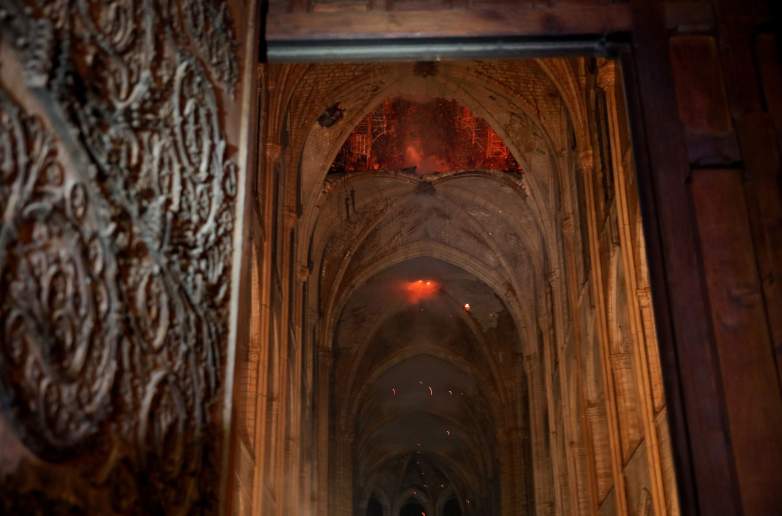
GettyFlames and smoke rise from the interior of Notre-Dame Cathedral in Paris on April 15, 2019, after a fire engulfed the building. – A huge fire swept through the roof of the famed Notre-Dame Cathedral in central Paris on April 15, 2019, sending flames and huge clouds of grey smoke billowing into the sky.
Paris is known for its art, of course, and some of its greatest works were housed inside Notre Dame.
According to CNN, Notre Dame contained at least 76 paintings that represent “the New Testament’s Acts of the Apostles, including the crucifixion of St. Peter and the conversion of St. Paul.” They date to the 1600s and 1700s.
The cathedral also housed a Jean Jouevnet painting on the Virgin Mary called “The Visitation,” CNN reports, adding that a 1600s-era painting of St. Thomas Aquinas was also hanging inside Notre Dame.
Sixteen religious statues were safe because they were removed from the cathedral before the fire due to the renovation project underway there.
The Organ
The Great Organ at Notre Dame dated to the Middle Ages. The organ has also survived. You can read about its background here.
The Stained-Glass Rose Windows
The stained-glass rose windows at Notre Dame are world-famous. The South Rose window was “offered by King St. Louis” and dates to 1260, according to The Washington Post. According to the cathedral website, the three rose windows “constitute one of the great masterpieces of Christianity.”
It’s now been confirmed by officials that the rose windows survived.
